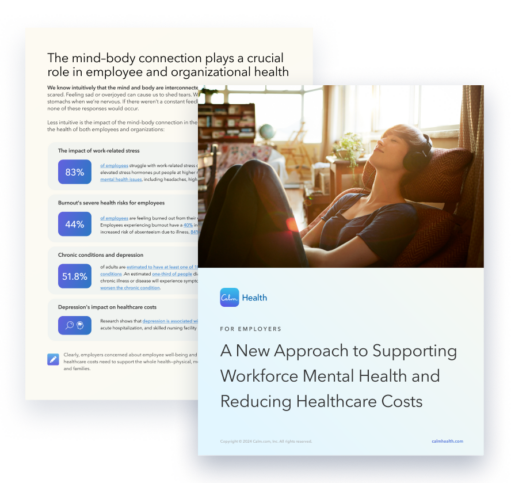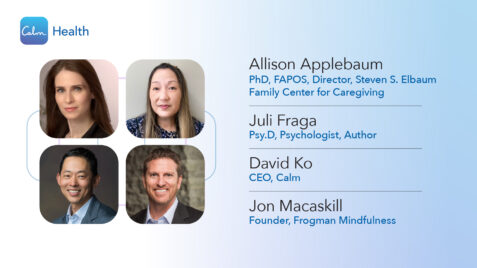Clinically reviewed by Chris Mosunic, PhD, RD, MBA, Chief Clinical Officer, Calm
TL;DR
- More than half of US workers report feeling lonely, but loneliness isn’t simply a reflection of working from home.
- Loneliness is associated with chronic health conditions, low productivity, poor job satisfaction, and attrition.
- Bringing everyone back to the office isn’t a sufficient solution. A multipronged approach, including evidence-based mental health support for loneliness, is needed.
An employee’s loneliness might seem like a personal struggle—something they should handle on their own, outside the concern of managers or HR leaders.
But loneliness isn’t a rare experience in today’s workforce. It’s widespread and quietly undermining employee health, engagement, productivity, and job satisfaction. Leaders concerned about organization performance need to recognize that creating a culture of belonging is an organizational imperative.
How many workers are lonely, and how is it measured?
According to Cigna’s Loneliness in America 2025 report, more than half of US workers (~52%) are feeling lonely. That’s an alarming proportion of the workforce and significantly higher than the 15% of workers cited in Gallup’s 2025 State of the Global Workplace survey.
The discrepancy reflects different survey approaches. Gallup measured loneliness by asking if a worker experienced loneliness a lot of the day yesterday, thereby capturing momentary feelings of loneliness. By contrast, Cigna’s annual survey uses the UCLA Loneliness Scale to probe respondents about feeling isolated, left out, or lacking in companionship over time, capturing ongoing disconnection and chronic loneliness.
Workplace loneliness isn’t about working from home
What does workplace loneliness look like?
According to Dr. Stuart Lustig, National Medical Executive for Behavioral Health at Evernorth, loneliness is the gap between the relationships you think you need and the relationships you actually have.
Therefore, workplace loneliness isn’t about one’s work location. A remote employee can feel perfectly content working alone, while an employee surrounded by coworkers in a shared space can feel terribly lonely. Loneliness is subjective and can exist regardless of one’s immediate surroundings.
Loneliness also shows up differently in people. While some may feel sad, others may feel misunderstood or simply that they don’t fit in. Still others feel anxious or depressed.
How does chronic loneliness affect health?
Indeed, chronic loneliness isn’t just a bad feeling; it puts a person at higher risk for anxiety and depression. And people with mental health issues are more than twice as likely to be lonely as those with good mental health.
Chronic loneliness is also a risk factor for serious physical health issues. When some people experience loneliness, their cortisol levels rise, possibly impairing cognitive abilities and increasing the risk for inflammation, vascular problems, and heart disease, for example.
How does loneliness affect the workplace?
It’s not surprising, then, that pervasive loneliness is costly for employers. Loneliness can reduce creativity, erode performance, and leave employees feeling emotionally exhausted.
An employee who feels lonely is up to five times more likely to miss work due to stress and twice as likely to consider quitting. A lonely worker can cost employers up to $4,200 a year in lost workdays.
It’s time for a new approach to supporting the mental well-being of your employees. Start here!
Get the paper
Employers need a multipronged approach to combatting loneliness
Clearly, loneliness is a big, complex problem for employers—and one that can’t be solved by simply bringing people back into the office full-time. Organizations need a multipronged approach that
- Supports employees who are already struggling with loneliness to help them find relief and
- Helps employees form more meaningful connections with others.
Calm Health offers support for employees who feel lonely
As part of an extensive library of mental health and mindfulness content, Calm Health offers an evidence-based program specifically targeting loneliness. Transforming Loneliness: Tools to Reconnect, developed by psychologist Dr. Juli Fraga, offers tools to navigate loneliness and nurture deep, meaningful connections with others. The program is designed to reflect the unique nature of each listener’s journey toward connection and belonging.
These episodes are included:
- “How Loneliness Shows Up in Our Lives”
- “Counter Distress with Acceptance”
- “Tools to Outsmart Unhelpful Thoughts”
- “Meet Emotions with Opposite Action”
- “Jumpstart Connection with Curiosity”
- “Reflect and Take One Step”
- “Unplug to Express Yourself”
- “Tap into Natural Belonging”
The program also includes a “Building Your Loneliness Toolkit” worksheet.
Additional ways to combat workforce loneliness
To get at the root of workplace loneliness, however, leaders and managers can do more across the organization. Here are some recommended steps to take to establish or strengthen a culture of empathy, interdependence, and belonging:
- Design teams to be enduring. Research has shown that workforce loneliness is exacerbated by modern team design; i.e., fluid teams with several short-term or part-time members. Instead, focus on creating enduring teams with clear missions, explicit interaction norms, and stable membership.
- Train managers on empathy. To encourage employees to speak up, train managers to establish an environment of psychological safety and empathy. Forming empathy circles to allow employees to share challenges and learn coping strategies is one idea. Research has shown that employees will take interpersonal risks—e.g., ask questions, admit errors, or reach out to colleagues—when they know they have the support of leaders and teammates.
- Benchmark and track loneliness in the organization. Have managers proactively and periodically talk to their employees to discern the degree of loneliness and quality of connections on their teams, say organizational experts Constance Hadley and Mark Mortenson. As an intervention, they recommend creating “core” or “home base” teams defined by where people spend the majority of their time or by shared interests.
- Reward employees for supporting others. Employers that reward employees for building relationships with and supporting colleagues see higher employee satisfaction and happiness. Evolve your performance management system to factor this behavior into criteria for bonuses and promotions. On a more informal basis, introduce a system for gratitude notes and peer-to-peer recognition.
- Commit to holding company retreats or offsites. Commit to holding in-person events that help employees form connections. Make these events a priority and protect them from budget cuts when possible.
- Support employees in creating social clubs. Encourage employees to form cohorts around a hobby and meet in person at least once a month. Outside of social clubs, encourage remote employees to connect socially with a colleague on a regular basis, virtually or in person.
- Support the development of employee resource groups. To support underrepresented groups in your workforce, develop a framework to help them establish and run an employee resource group (ERG) effectively. Here are some tips for getting started.
- Continue to support diversity, equity, inclusion, and belonging. Celebrate cultural heritage months with your organization’s ERGs. Develop an annual calendar of heritage and awareness months and plan your events (virtual and/or in-person) and communications well in advance.
- Bring people together with mindfulness. Provide tools to help employees practice mindfulness in their day-to-day work experience. For example, encourage managers to start meetings with a 60-second meditation so employees can pause for a mindfulness break. Or, to help employees build strong, healthy relationships, encourage them to try the Relationships with Others series by Tamara Levitt, which is available on Calm Health and Calm.
- Adopt solutions to support employees with feelings of loneliness. In addition to the clinical program for loneliness, Calm Health offers mindfulness content specifically focused on supporting employees feeling lonely, including
- “Combating Loneliness,” with former U.S. Surgeon General Dr. Vivek Murthy;
- “On Loneliness,” with Julia Bainbridge, host of The Lonely Hour podcast; and
- “Aloneness,” with mindfulness expert Tamara Levitt.
Loneliness is a personal issue negatively affecting too many people and organizations. It’s time for employers and health plans to help workers create the meaningful and lasting connections that are critical to well-being, productivity, and performance.




